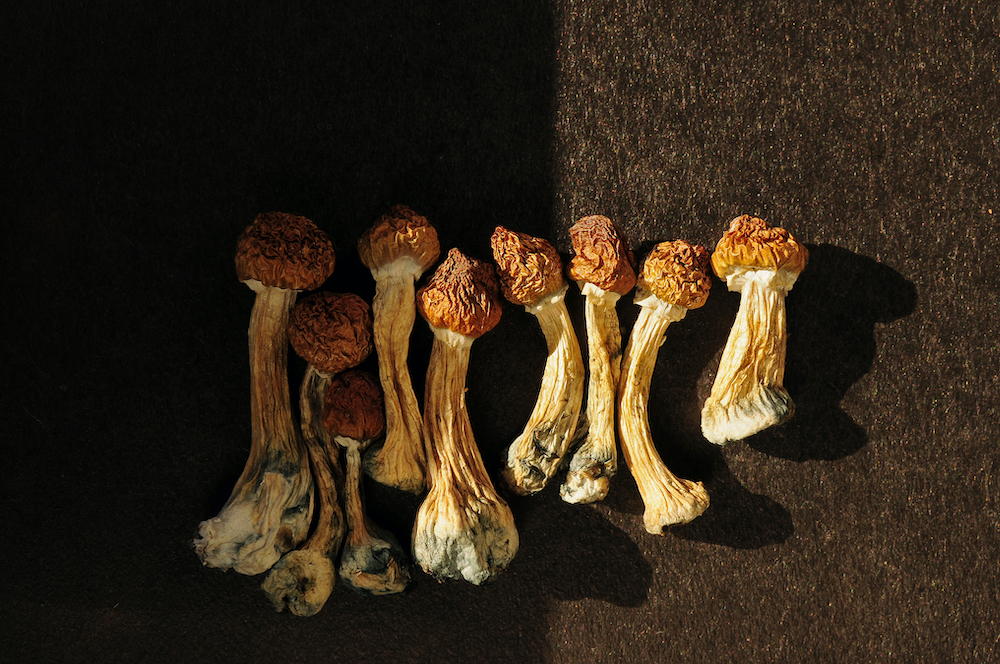Psychedelic Therapist Training: How to Become a Certified Psychedelic Therapist
What if I told you the next frontier in mental and physical health will be psychedelic therapist training?
There is growing evidence of MDMA’s efficacy for treating severe PTSD, and psilocybin’s ability to treat major depression. Taken with ibogaine’s unique ability to help people quit prolonged heroin addictions, psychedelics and their potential to help people heal their deepest wounds can simply no longer be ignored.
RELATED: Want to be connected with new job openings in the psychedelics industry? Let us know your details here.
The word psychedelics can now be heard at coffee shops, office water coolers, and dinner parties. It’s even entered the National Football League. When Aaron Rodgers, (one of the NFL’s most prominent superstars), opens up about his ayahuasca use with no repercussions, it is obvious a significant cultural shift has occurred.
Elsewhere, the CEO of TOMS, a U.S-based shoe and apparel brand, pledged to donate 100 million dollars to psychedelic research. John Hopkins University, one of the United States’ oldest public institutions, is currently conducting studies on topics such as the relationship between psychedelic drugs and consciousness. Globally, Australia became the first country to legalize MDMA and psilocybin for prescription use.
Psychedelics are clearly coming into our culture in all kinds of ways: through microdosing psilocybin (the active ingredient in “magic mushrooms”) or LSD, shamanic retreats, and “recreation.”
Psychedelic Therapist Training – The Therapeutic Path in Psychedelics
As the opportunity for psychedelic jobs grows, the most accepted route moving forward may be therapy. Therapy provides a path to administer psychedelics in a way that can be somewhat regulated and standardized.
Over the past 70-plus years in Europe and North America, psychedelic-assisted therapy has been proven to be relatively safe and effective. Over the next decade and beyond, as psychedelics are approved in more places, societies will be looking for thousands more mental healthcare professionals trained in psychedelic therapy.
With the growing prevalence of psychedelics in cultures across the world, there are natural questions that many people begin to wonder:
“How can I become a psychedelic therapist? How can I use my skills and training to enter this burgeoning field? What is my path toward psychedelic therapy?”
In this article, we dig into the many nuances of these questions.
We also get the chance to speak with Amanda Giesler (MHA), the Director of Training at Numinus. Numinus is a Vancouver-based psychedelic therapy clinic operator and educator, with locations across North America.
What is a Psychedelic Therapist?
Let’s start by defining what exactly a psychedelic therapist is. Psychedelic therapy is sometimes also referred to as psychedelic-assisted therapy, psychedelic psychotherapy, or psychedelic-assisted psychotherapy (PAP). Regardless, it is a form of therapeutic practice that involves two components:
- The ingestion, inhalation, or infusion of a psychedelic drug. This includes (psilocybin or psilocin pills, MDMA, LSD, ibogaine, ketamine, cannabis, ayahuasca, DMT ect.).
- A traditional psychotherapeutic practice such as Gestalt Therapy, Somatic Experiencing, Internal Family Systems (IFS), Psychodynamic Therapy, and many others.
A couple important caveats:
Without the pairing of a therapeutic practice, psychedelic use is usually considered recreational.
– Although experts say that recreational use has its time, place, and own healing potential, psychedelic therapy is thought to be so effective because of the addition of a therapeutic practice.
The role of a psychedelic in psychedelic therapy should be seen as a catalyst, or an aid, to the healing process.
– Although we are all born with innate inner-healing potential (sometimes referred to as the “inner healer”), it can be difficult to access this on your own. A trained psychedelic therapist can help someone find and access their inner healer.
It varies from the city/state/country you reside in, but a psychedelic therapist is typically a licensed mental healthcare professional. This includes clinical psychologists, psychiatrists, clinical social workers, registered nurses, nurse practitioners, and chaplains, who have received additional, specialized training in psychedelic therapy.
READ NEXT: 4 Different Therapeutic Techniques Used With Psychedelic Therapy
Where is Psychedelic Therapy Legal?
Psychedelics are still illegal in most capacities in many parts of the world. This includes most of the United States and Canada, other than extremely specific uses.
(This piece primarily focuses on psychedelic therapy in the U.S. and Canada. Everyone should be acutely aware of their local laws and regulations regarding psychedelics. Especially if you are interested in becoming a psychedelic therapist.)
In the United States, the FDA (Food and Drug Administration) still considers most psychedelics Schedule One drugs. This means they are currently classified as having no accepted medical use and a high potential for abuse.
In the situations where they are legal, official psychedelic therapy sessions are usually only conducted in clinical trial settings, or in a government approved psychedelic therapy center.
Ketamine-Assisted Psychotherapy Training
There are a couple other legal avenues to conduct psychedelic therapy; mainly ketamine and cannabis (in certain states). Ketamine is an anesthetic that can be prescribed off-label across the states as a treatment for depression or other ailments. Therapists can also combine ketamine with traditional psychological treatments. Training in ketamine-assisted therapy is available across the world.
The field is evolving rapidly however, and many avenues are opening.
Colorado recently passed the Natural Medicine Health Act. And the FDA is expected to approve prescription MDMA-assisted therapy for severe PTSD. Colorado will begin accepting applications for psilocybin facilities in late 2024.
In 2020, The Psilocybin Services Act passed in Oregon. Today, Oregon has supported-use sessions where adults can take psilocybe cubensis mushrooms with a trained facilitator.
RELATED: Tens of Thousands of Trained Psychedelic Practitioners Needed, Experts Say

What is the Training to Become a Psychedelic Therapist Like?
Psychedelic-assisted therapy is an extremely young profession, and many of the qualifying requirements are still being hashed out and solidified.
You might have some important questions before getting started with psychedelic therapist training.
- Do I already need to be a therapist to become a psychedelic therapist?
- What qualifications do I need?
- How long does it take to become a psychedelic therapist?
- What is the typical salary range?
- Are there any other considerations I should take into account?
Do I Already Need to be a Therapist to Become a Psychedelic Therapist?
Many psychedelic training centers do require some form of professional license for admittance, mental health training, or a certain number of hours of direct experience working with clients in a therapeutic setting.
While students will need to be a licensed health professional in order to take the practical applications portion of the certification pathway (they will get the opportunity to observe real clients), most of their courses do not require a professional license.
What Qualifications do I Need?
It’s still not completely clear in most instances. Here’s some of what is known:
Psychedelic Therapist Training in Colorado
Unfortunately, the requirements for someone to be able to provide psychedelic-assisted therapy in Colorado are not expected to be released by the Colorado Department of Regulatory Agencies until January 1st, 2024.
Federal Psychedelic-Assisted Therapy
As for the potential to conduct MDMA-assisted therapy anywhere in the United States, the requirements to do so will not be available until MDMA-assisted therapy is approved by the FDA for prescription use.
When I asked Amanda Giesler (MHA, Director of Training at Numinus) if the Numinus MDMA-assisted therapy certification would allow someone to provide MDMA therapy after FDA approval, she said:
“Our MDMA-assisted therapy training program is based off of the MAPS protocol, which is what is currently being reviewed by the FDA for future U.S. federal approval. Assuming this MDMA-assisted therapy receives FDA approval, practitioners who are trained through our MDMA-assisted therapy Certification Pathway will be well prepared to offer the treatment in the future.”
Psychedelic Therapist Training in Oregon
In Oregon, the requirements are much more clear. The Oregon Health Authority published the following facilitator license requirements:
Facilitator License Requirements:
- Must be 21 years of age or older.
- Must have a high school diploma (or equivalent).
- Must be a resident of Oregon (this provision expires in 2025).
- Must complete a facilitator training program with curriculum that has been approved by Oregon Psilocybin Services. (Numinus is working through the application for their training to be approved.)
- Must pass the Oregon Psilocybin Services Regulations Exam.
- Must pass a criminal background check.
- Must pay a license application fee.
- Must pay an annual license fee.
You can find more information about the Oregon facilitator application process here.
Psychedelic Therapy in Canada
In Canada, MDMA and psilocybin have been legalized for prescription use in limited settings. In order to provide psychedelic-assisted therapy in Canada, “health care practitioners need appropriate authorizations from Health Canada under both the FDA (Food and Drugs Act), and the CDSA (Controlled Drug and Substances Act)”.
At the moment, only licensed healthcare professionals can apply to provide psychedelic therapy in Canada.
LEARN MORE: Psychedelic-Assisted Therapy Certifications and Trainings
How Long Does it Take to Become a Psychedelic Therapist?
“Working in this field is a life-long learning process–while you can become certified in a relatively short period of time, it is critical that practitioners working in this field continue to take professional development programs, join community practice groups, and discuss their practice with peers on an ongoing basis.”
– Amanda Giesler, Director of Training at Numinus
The length of time it will take you to become a psychedelic therapist will vary significantly depending on a number of factors.
Your background, years of experience, whether you have a license, and how much inner work you have done can affect the amount of time it takes to become a psychedelic-assisted therapist drastically.
I spoke with Amanda about what someone can expect going through the Numinus program:
“If you are a regulated health professional working in mental health care, it can take 3-6 months to come through the entire certification pathway for a particular medicine with Numinus. This includes your in-person experiential learning and practicum placements at a Numinus clinic to gain valuable personal and client experiences before beginning any of this work on your own. Working in this field is a life-long learning process – while you can become certified in a relatively short period of time, it is critical that practitioners working in this field continue to take professional development programs, join community practice groups, and discuss their practice with peers on an ongoing basis…Highly successful providers in this field will be the ones who prioritize continuing education in their practice.”
As Amanda summarizes so well, there is a lot more to being a psychedelic therapist than completing a training program. Because of that, the length of time it will take to become one will be different for everyone.
RELATED: Here’s How Psilocybin Therapy Is Changing The Way People Treat Mental Health Issues
What is the Typical Salary Range for a Psychedelic Therapist?
How much money will a psychedelic therapist make per year?
No one quite knows yet.
“There is a vast range depending on skill set, experience, and qualifications/ designation (e.g. MD, LCSW, LMFT, RCC, etc.),” according to Amanda. “While it’s hard to provide a definitive range, positions in this field generally align with market salaries based on the professional designation. Remuneration isn’t yet based on psychedelic-specific expertise, however career and job opportunities in this field are becoming more abundant and the roles will require training and certification.”
Much like the length of time it will take someone to become a psychedelic therapist, the typical salary range will be different for everyone.
It will depend significantly on where someone is entering the field from, what someone’s professional designation is, where in the world they live, how many sessions they do a year, whether they work with groups or individuals, and many other factors.
RELATED: Psychedelics in Therapy – The Next Generation of Treatment
Are There Any Other Considerations I Should Take Into Account?
“Numinus recommends and emphasizes being physiologically and energetically grounded, self-regulated, and aligned when working with individuals in altered states of consciousness and with those who have experienced significant traumatic stress.”
– Amanda Giesler, Director of Training at Numinus
Perhaps the most important consideration if you are thinking about becoming a psychedelic-assisted therapist is a vigorous focus on your own healing and inner work.
The best therapists are not only ones who are kind, empathetic, and creative. But they are also typically the ones who have done an enormous amount of their own healing.
“Numinus recommends and emphasizes being physiologically and energetically grounded, self-regulated, and aligned when working with individuals in altered states of consciousness and with those who have experienced significant traumatic stress,” according to Amanda. “It requires a well-honed capacity to self-monitor and consciously modulate one’s nervous system, emotional state, and mental formations at will. It also supports the open, non-judgmental stance of empathetic abiding presence.”
A therapist may be hearing some of their clients’ most painful memories or feelings, and if any of those memories bring something up in the therapist, it is essential that a therapist be able to either avoid being triggered as much as possible or be able to self-regulate quickly and remain present and grounded with the client.
These skills are typically only achieved after someone has spent an enormous amount of time focused on healing their deepest wounds.
“For health professionals, strong mindfulness supports strong and stable empathetic abiding presence. Numinus trained practitioners are expected to have an ongoing practice cultivating mindfulness because it is a foundation for psychedelic-assisted therapy.”
– Amanda Giesler, Director of Training at Numinus
Those Who Care for Others Must Also Look After Themselves
Another consideration to take into account is that providing psychedelic therapy requires an incredible amount of sustained self-care.
Broadly speaking, self-care is the practice of maintaining or improving mental, physical, and emotional health through mental or physical activity, such as mindfulness.
“For health professionals, strong mindfulness supports strong and stable empathetic abiding presence,” said Giesler. “Numinus trained practitioners are expected to have an ongoing practice cultivating mindfulness because it is a foundation for psychedelic-assisted therapy.”
(If you want to dig deeper into Numinus’s self-care practices, you can read more here.)
Although self-care is of vital importance for many professionals, it is especially important for therapists.
Not only does it help prevent and treat burnout, but it also helps a therapist be present for their clients during a session. An emotionally drained or physically exhausted therapist may not be in the best headspace to provide support. That in of itself can cause harm to the client.
Self-care is also an ethical requirement for most licensed mental healthcare professionals in the United States and Canada.
LEARN MORE: Psychedelic-Assisted Therapy Certifications and Trainings
The Nuances of Psychedelic-Assisted Therapy Training
As you can see, the seemingly simple question of “How can I become a Psychedelic Therapist” becomes quite complex once we dig in.
While providing psychedelic therapy is one of the most rewarding and fulfilling careers out there, it also requires a high amount of sustained self-work, self-care, dedication, and continuing education.
The most successful psychedelic therapists will be the ones who are dedicated to working on themselves as much as with their clients.
If you are ready to begin your journey to become a psychedelic therapist, the Numinus training programs are a great place to start. They are extremely accessible, thorough, in-depth, and Numinus strongly believes in the importance of self-work and self-care.
Aside from helping someone become a psychedelic therapist, there are several other ways in which the Numinus courses can support ongoing practices. This includes:
1. Physicians supporting the prescribing aspects of this work.
2. Therapists who have a busy talk therapy practice but want to add psychedelic-assisted therapy into their scope of work.
3. Clients wanting to learn more about specific psychedelic medicines. For example, you can take the Molecular Foundations courses.
4. New graduates of health related disciplines that want to pursue a career in psychedelic-assisted therapy and are interested in being part of interdisciplinary health care teams providing services in a clinic, like the ones that operate at Numinus.
5. Non-regulated professionals wanting certificates/credentials in this work. This can include coaches, sitters, and other support functions.
You can read all about their courses, and how they can help you advance your practice here. The chart below illustrates the variety of educational paths you can take with Numinus
Psychedelic Therapist Training – New Horizons, New Opportunities in Psychedelic-Assisted Therapy
When you look around, it’s hard to deny that it truly is a fascinating time to be alive. A true medical revolution seems to be underway. What was once criminalized, demonized, and considered taboo is now becoming the best hope for many of the most severe mental and physical health conditions.
While indigenous groups across the world have been using psychedelics for therapeutic and religious uses for thousands of years, psychedelics have just recently entered the western world and the western medical model. Where the industry goes from here is up to all of us.
Whether we learn to use psychedelics responsibly, safely, and sustainably depends in part on the training our practitioners receive. It’s a duty that lies in many hands–maybe even yours.
Are you ready to get started?



